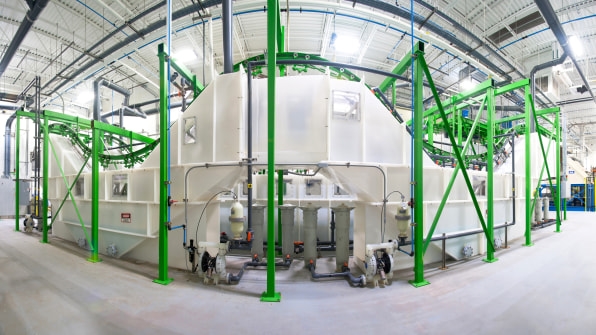The global surge in solar power is helping quickly lower the cost of solar panels and shrink energy’s carbon footprint, with around 70,000 solar panels being installed every hour by 2018, and an estimated 1.47 million solar panels in place by that year in the U.S. alone. But it also means that we’ll face an enormous pile of e-waste when those panels eventually wear out.
By the early 2030s, as one large wave of solar panels is reaching the end of life, the International Renewable Energy Agency projects that there could be as much as 8 million metric tons of total solar panel waste. By 2050, that could jump to as much as 78 million metric tons of cumulative waste. “We’re looking at an emerging waste stream which has the potential to go to pretty large volumes over the next decade,” says Andreas Wade, who leads global sustainability for First Solar, a solar panel manufacturer that is taking on the problem with a circular approach.
At a recycling plant in Ohio, next to the company’s manufacturing facility, First Solar uses custom technology to disassemble and recycle old panels, recovering 90% of the materials inside. It runs similar recycling systems in Germany and Malaysia. Right now, the holistic lifecycle approach isn’t common among other solar producers. But Wade says that now is the time to think about the problem. “Our aim for solar is to help our customers decouple their economic growth from negative environmental impacts,” he says. “So it is kind of a mandatory point for us to address the renewable-energy-circular-economy nexus today and not 20 years from now.”

The E.U. requires solar producers to recycle products, and similar laws are in the works in some other parts of the world, including Japan and India. In the U.S., so far, only the State of Washington requires solar panel recycling; the majority of old solar panels in the country end up in landfills now, wasting valuable materials such as silicon and risking the spread of toxic components such as lead.
By recycling materials, the total environmental impact of each panel drops. The original solar panel, Wade says, might last 30 or even 40 years. If 95% of the semiconductor material can be recovered and put back in a new panel, and the cycle continues to repeat, the original material could stay in use as long as 1,200 years. At the moment, because of the huge demand for solar panels and the fact that many haven’t yet reached the end of their life, the total percentage of recycled material in the company’s new panels is low. But it will grow over time.
As the industry progresses, recycling options are also likely to grow. At industrial-scale solar farms, Wade predicts that mobile recycling units will start to be used, helping alleviate the challenge of shipping heavy, glass-covered solar panels to a distant recycling plant. (Current transportation costs can be so large that some in the industry say that it can be difficult to make recycling cost-effective.)
Now, some large buyers of solar power are beginning to think more about solar’s total impact. When GM recently signed an agreement to buy power from a new solar development as part of its effort to move to 100% renewable energy, for example, it decided to work with First Solar because the company was working on the sustainability of the whole supply chain.
(36)